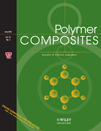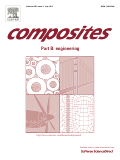
POLYMER COMPOSITES
Scope & Guideline
Shaping the Future of Composite Technologies
Introduction
Aims and Scopes
- Development of Advanced Composite Materials:
Research on new polymer composites with enhanced properties, including strength, thermal stability, and electrical conductivity, often achieved through innovative reinforcement strategies and novel processing methods. - Interfacial Properties and Adhesion:
Investigation into the interfacial interactions between fibers and matrices, including the effects of surface modifications and treatments that improve adhesion and mechanical performance. - Sustainable and Biodegradable Composites:
Exploration of environmentally friendly materials, including biocomposites derived from natural fibers and biodegradable polymers, focusing on their mechanical properties and applications in sustainable engineering. - Multiscale Modeling and Simulation:
Use of computational methods to predict the behavior of polymer composites at various scales, from molecular dynamics simulations to macroscopic modeling, facilitating the understanding of complex material behaviors. - Thermal and Mechanical Characterization:
Comprehensive studies on the thermal and mechanical properties of composites, including investigations on damping, fatigue, and impact resistance under different environmental conditions. - Nanocomposite Innovations:
Research on the incorporation of nanomaterials into polymer matrices to enhance properties such as thermal conductivity, mechanical strength, and electrical performance.
Trending and Emerging
- Smart and Multifunctional Composites:
There is a growing interest in developing composites with integrated functionalities, such as self-sensing, self-healing, and adaptive properties, which are critical for advanced applications in aerospace and automotive sectors. - Bio-based and Sustainable Materials:
Research on bio-based composites and sustainable materials is gaining momentum, with a focus on utilizing agricultural and industrial waste, reflecting an increasing demand for environmentally friendly alternatives. - Advanced Nanomaterials and Hybrid Fillers:
The use of advanced nanomaterials, such as graphene and carbon nanotubes, as well as hybrid fillers, is becoming more prevalent, enhancing the mechanical, thermal, and electrical properties of composites. - Additive Manufacturing Techniques:
The rise of 3D printing technologies for fabricating polymer composites is a significant trend, allowing for complex geometries and tailored material properties, thus broadening application scopes. - Computational Modeling and Simulation:
There is an increasing emphasis on integrating computational methods with experimental approaches to predict the behavior of polymer composites, enhancing design capabilities and material optimization. - Thermal Management Applications:
Research focusing on the thermal management capabilities of composites, particularly in electronic and aerospace applications, is emerging as a critical area, driven by the need for efficient thermal solutions.
Declining or Waning
- Traditional Reinforcement Techniques:
Research on conventional fiber reinforcement methods, such as glass and carbon fibers, has seen a decrease as newer materials and hybrid approaches gain popularity. - Static Mechanical Testing:
Studies predominantly focusing on static mechanical properties without considering dynamic or environmental factors are becoming less prevalent, as there is a growing emphasis on real-world applications and conditions. - Single Material Systems:
The focus on single polymer systems without hybridization or composite approaches is waning, as the trend shifts towards creating multifunctional materials that combine various properties. - Basic Manufacturing Techniques:
Research centered around traditional manufacturing techniques, such as simple molding processes, is declining as advanced additive manufacturing and automated processes are prioritized. - Limited Environmental Impact Studies:
Research that does not consider the environmental impact of materials and processes is becoming less common, as sustainability becomes a critical aspect of material development.
Similar Journals

IRANIAN POLYMER JOURNAL
Advancing the Frontiers of Polymer ScienceWelcome to the Iranian Polymer Journal, an esteemed publication encompassing a rich history since its inception in 1996 and extending its scholarly reach up to 2024. Published by Springer from Switzerland, this journal stands out in the fields of Chemical Engineering, Materials Chemistry, and Polymers and Plastics, proudly holding a Q2 category ranking in each of these disciplines for 2023. With an ISSN of 1026-1265 and an E-ISSN of 1735-5265, the journal serves as a vital resource for researchers, professionals, and students, offering insights into polymer science and interdisciplinary applications. Although not an open-access journal, it presents an invaluable platform for high-quality research dissemination and robust peer-reviewed articles. With Scopus rankings indicating its respected position within the academic community, the Iranian Polymer Journal is committed to advancing knowledge and fostering innovation in polymer-related studies, making it an essential addition to your research library.

FIBERS AND POLYMERS
Unveiling Breakthroughs in Fiber and Polymer TechnologyFIBERS AND POLYMERS is a prestigious scholarly journal published by the Korean Fiber Society, specializing in the fields of Chemical Engineering, Chemistry, and Polymer Science. Since its inception in 2000, the journal has provided a dynamic platform for researchers and professionals to disseminate cutting-edge findings and innovative methodologies related to fibers, polymers, and their diverse applications. With its Q2 category ranking across multiple disciplines in 2023 and a commendable standing in Scopus rankings—ranking #183 in General Chemistry and #127 in General Chemical Engineering—it is well-regarded within the academic community. The journal’s commitment to quality research is further underscored by its comprehensive coverage of technological advancements and theoretical developments relevant to both industry and academia. Access to published articles may vary, and authors are encouraged to submit original research to contribute to this evolving field. Join the community shaping the future of materials science through FIBERS AND POLYMERS.

MACROMOLECULAR RESEARCH
Fostering Collaboration in Macromolecular DiscoveryMACROMOLECULAR RESEARCH, published by the POLYMER SOC KOREA, is a premier journal dedicated to advancing the field of macromolecular science and polymer engineering. With its ISSN 1598-5032 and E-ISSN 2092-7673, this journal has emerged as a vital platform for researchers and professionals interested in the application and development of polymers across various domains. Based in South Korea and operating as an open-access resource since its inception in 2002, MACROMOLECULAR RESEARCH consistently ranks in the Q2 category across diverse fields such as Chemical Engineering, Materials Chemistry, and Organic Chemistry as per the latest 2023 metrics. Notably, it is recognized for its substantial contributions to polymery science, increasing its visibility and impact in global research. By providing a forum for original research articles, reviews, and innovative methodologies, this journal aims to foster collaboration and knowledge sharing among scientists, engineers, and students alike. Join a community that is at the forefront of polymer research by exploring the wealth of resources and cutting-edge studies featured in MACROMOLECULAR RESEARCH.

Composites Part C: Open Access
Exploring the Future of Mechanical EngineeringComposites Part C: Open Access, an esteemed journal published by Elsevier, is at the forefront of research in the fields of Ceramics and Composites, Mechanical Engineering, and Mechanics of Materials. Launched in 2020, this fully open-access journal facilitates unparalleled access to significant advancements in composite materials, ensuring that research findings are disseminated widely and freely throughout the global academic community. With an impressive Q1 ranking across multiple related categories and robust placements in Scopus rankings, specifically #78 in Mechanical Engineering and #24 in Materials Science, the journal serves as a vital platform for researchers, professionals, and students to publish their work and engage with cutting-edge studies. It aims to foster innovation and collaboration in the development and application of composite materials and their technologies, making it an indispensable resource for anyone invested in these dynamic fields.

POLYMERS & POLYMER COMPOSITES
Innovating Tomorrow's Composite SolutionsPOLYMERS & POLYMER COMPOSITES, published by SAGE Publications Ltd, is a prestigious journal dedicated to the exploration of significant advancements in the diverse fields of polymers, composite materials, and their innovative applications. With an ISSN of 0967-3911 and E-ISSN of 1478-2391, this journal plays a crucial role in the academic community, boasting an impressive ranking in the Q2 quartile across pivotal categories such as Ceramics and Composites, Materials Chemistry, and Polymers and Plastics in 2023. Positioned in the United Kingdom, it serves as a vital resource for researchers and professionals, providing insights into current trends and future directions in material science. Despite its availability not extending to Open Access, the journal aims to promote rigorous peer-reviewed research, thus fostering knowledge and collaboration among scholars. With publication convergence from 1993 to 2024, POLYMERS & POLYMER COMPOSITES stands as a cornerstone for those pursuing advanced understanding and excellence in material innovation.

Journal of Macromolecular Science Part B-Physics
Driving Knowledge at the Nexus of ScienceThe Journal of Macromolecular Science Part B-Physics, published by Taylor & Francis Inc, is a critical platform for advancing knowledge in the realms of macromolecular science and interdisciplinary research at the intersection of physics, chemistry, and materials science. With an ISSN of 0022-2348 and E-ISSN of 1525-609X, this journal has been a cornerstone of scientific discourse since its inception in 1967, continuing to offer invaluable insights and innovative findings through to 2024. The journal holds a Q3 ranking across several disciplines, including Chemistry (miscellaneous), Condensed Matter Physics, Materials Chemistry, and Polymers and Plastics, reflecting its relevance and importance within the scientific community. Although it does not support open access, the rigor of its peer-review process ensures that published articles meet the highest standards of scientific excellence. Researchers, professionals, and students alike will find the journal an essential resource for the latest trends and discoveries in macromolecular physics, aiding in both academic pursuits and practical applications in material design and analysis.

Elastomers and Composites
Shaping Tomorrow's Materials Through Rigorous ScholarshipElastomers and Composites is a leading academic journal dedicated to the advancement of knowledge in the fields of polymer science and materials engineering, specifically focusing on elastomers and composite materials. Published by RUBBER SOC KOREA, this journal serves as a vital platform for researchers and professionals to disseminate innovative research findings and insights in material properties, applications, and synthesis techniques. Although it currently does not offer open access, the journal provides rigorous peer-reviewed content that enhances the global dialogue on elastomeric materials and their composites, reflecting its commitment to high-quality scholarship. With a strong emphasis on practical relevance and theoretical advancements, Elastomers and Composites aspires to reshape industry practices and academic thought, making it an invaluable resource for students, researchers, and practitioners alike. Positioned strategically within its field, this journal fosters collaboration and dialogue among scientific communities, all while supporting the growth of cutting-edge research programs worldwide.

Revue des Composites et des Materiaux Avances-Journal of Composite and Advanced Materials
Transforming Ideas into Advanced Material ApplicationsRevue des Composites et des Materiaux Avances - Journal of Composite and Advanced Materials is a prominent academic journal published by the INT INFORMATION & ENGINEERING TECHNOLOGY ASSOC, based in France. With an ISSN of 1169-7954 and an E-ISSN of 1958-5799, this journal serves as a critical platform for the dissemination of innovative research in the field of composite and advanced materials. Currently categorized in the Q3 quartile of Materials Science and ranking 326 out of 463 in its category according to Scopus, the journal aims to bridge the gap between theoretical advancements and practical applications in material science. As it embraces an open-access model to increase accessibility, it caters to a diverse audience, including researchers, professionals, and students interested in cutting-edge materials technology. The journal covers a wide scope of topics ranging from manufacturing processes to material characterization, contributing significantly to the ongoing discourse in this evolving field. With convergence years extending from 2012 to 2024, it is poised to be an essential resource for anyone looking to stay abreast of the latest developments in composite science.

COMPOSITES PART B-ENGINEERING
Driving Excellence in Materials Science and EngineeringCOMPOSITES PART B-ENGINEERING, published by Elsevier Science Ltd, stands at the forefront of research in the fields of engineering and materials science, specifically targeting the domains of composites, ceramics, and mechanical engineering. With an impressive impact factor and categorized in the prestigious Q1 quartiles across multiple categories including Industrial and Manufacturing Engineering and Mechanics of Materials, this journal fosters innovative research that significantly contributes to the advancement of composite materials and their applications. The journal has been diligently publishing high-quality peer-reviewed articles since its inception in 1996, and it continues to attract top-tier contributors and researchers who are dedicated to exploring emergent technologies and methodologies. Researchers, professionals, and students will find valuable insights and an extensive pool of resources in this essential journal, available through Open Access options that enhance its visibility and reach, allowing the dissemination of crucial knowledge to the global scientific community.

Functional Composites and Structures
Driving Innovation in Composite Applications.Functional Composites and Structures is a prestigious academic journal published by IOP Publishing Ltd, dedicated to advancing the field of materials science with a focus on innovative composite materials and their structural applications. Established in 2019 and running through 2024, this journal uniquely bridges several disciplines, consistently ranking in the Q2 quartile across key categories including Ceramics and Composites, Electronic, Optical and Magnetic Materials, and Mechanics of Materials. With a commendable Scopus rank that places it within the top tiers of its field, the journal is instrumental for researchers, engineers, and scholars seeking to explore the latest developments in material properties, functionality, and applications. Although access options are not specified, the open-access nature of the journal promotes wider dissemination and engagement with cutting-edge research. As the demand for smarter, more efficient materials continues to grow, Functional Composites and Structures serves as a vital resource for fostering collaboration and driving innovation in material sciences.